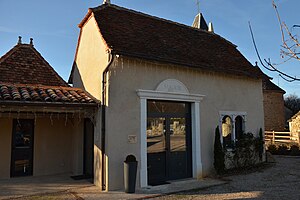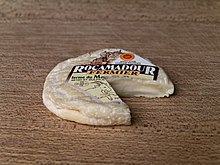Albiac (Lot)
| Albiac | ||
|---|---|---|
|
|
||
| region | Occitania | |
| Department | Lot | |
| Arrondissement | Figeac | |
| Canton | Gramat | |
| Community association | Grand Figeac | |
| Coordinates | 44 ° 46 ′ N , 1 ° 49 ′ E | |
| height | 324-430 m | |
| surface | 3.83 km 2 | |
| Residents | 70 (January 1, 2017) | |
| Population density | 18 inhabitants / km 2 | |
| Post Code | 46500 | |
| INSEE code | 46002 | |
| Website | www.albiac.fr | |
 Mayor's Office ( Mairie ) of Albiac |
||
Albiac is a French commune with 70 inhabitants (as of January 1, 2017) in the Lot department in the Occitania region (before 2016: Midi-Pyrénées ). The municipality belongs to the arrondissement of Figeac and the canton of Gramat (until 2015: canton Lacapelle-Marival ).
The current name of the municipality is derived from the earlier names albiacum and villa albii (country estate of Albius).
The inhabitants are called Albiacois and Albiacoises .
geography
Albiac is about 25 km northwest of Figeac in the historic province of Quercy .
Albiac is surrounded by the five neighboring communities:
| Saignes | ||
| Bio |

|
Aynac |
| Issendolus | Thémines |
Albiac is located in the catchment area of the Dordogne River .
Tributaries of the Ouysse have their source in the municipality:
- the Ruisseau de Lascombes and
- the Ruisseau du Morou with its tributary
- the Ruisseau d'Albiac.
The Ruisseau de Saignes, a tributary of the Ruisseau de Bio, forms the natural border with the northern neighboring municipality of Saignes.
history
Settled more than 2,300 years ago at the site with the field names Goudounesque Ligurians . A Roman villa and a Roman road contributed to the development of the village in Gallo-Roman times .
A first chapel was probably built in the course of the ninth century as part of the Christianization . From this Sancti Petri de Albiaco a priory developed that was subordinate to the Benedictine monastery of Marcilhac-sur-Célé . This was sold to Baron Hugues II von Castelnau- Gramat and his wife Hermentrude, who gave it to the Bishop of Cahors in 986 . The priory was attached to the Viguerie of Aynac in the 10th century . This structure lasted for centuries until the French Revolution . A new priory was likely built between 1250 and 1330, while the first seemed too small and outdated. His church was built on the foundations of the earlier Carolingian chapel. During the Hundred Years' War that followed, the majority of the churches, monasteries and castles in the area were looted, set on fire or destroyed. Albiac, Bio and Gramat suffered particularly under the English occupation between 1369 and 1378. The religious activities of the priory are likely to have come to a standstill by 1370 at the latest. From the 14th to the 16th century, the now simple parish church belonged to the archpriesthood of Thégra , which comprised more than 75 parishes. The parish of Albiac was temporarily independent, at times a branch of Bio, until the merger of the two parishes was completed in 1483. This connection lasted until the French Revolution.
Population development
At the beginning of the 19th century the number of inhabitants rose to a high of around 330. In the following period the size of the community fell to 60 inhabitants during short recovery phases until the 1990s, before a growth phase set in that has stagnated again in more recent times.
| year | 1962 | 1968 | 1975 | 1982 | 1990 | 1999 | 2006 | 2011 | 2017 |
|---|---|---|---|---|---|---|---|---|---|
| Residents | 86 | 77 | 70 | 72 | 60 | 66 | 77 | 89 | 70 |
Attractions
Parish Church of Saint-Pierre
After the destruction in the Hundred Years War with repeated damage, the church was rebuilt in the middle of the 16th century. The dating of the big bell supports this assumption. The Carolingian predecessor church was located under the choir of today's church. This is evidenced by the discovery of four pre-Romanesque pillars during renovation work in 1994. Two pillars are partially visible on the northeast side. Originally the main entrance was at the level of the narthex on the west side. When the castle was enlarged by the Roquemaurel family in 1670, the entrance was moved to the south side. At the same time, a connecting door was laid from the castle to the gallery for direct access. This was bricked up in 1994. In 1837 there was only one chapel on the south side under the bell tower . A sacristy was then built, and a north side chapel between 1863 and 1879 as the population of Albiac had increased at that time. During the 19th century, wall paintings were created inside, which were visible until the renovation work in 1994. In 2012, contemporary style stained glass windows , works by glass painter Roseline Chanvin, were used.
Albiac Castle
Hugues de Thémines, brother of Girbert I. de Thémines, was Seigneur of Albiac in 1263. Girbert I de Thémines previously paid homage to the French King Louis IX. for his castle, Albiac In 1242. Subsequently, a family who took their name from Albiac sided with the English in the Hundred Years War. Jean d'Albiac was therefore convicted, and his property was confiscated and auctioned. At the end of the 14th century, the family had to leave France for England. Béthon de Roquemaurel, who bought Thémines and the territories in 1416, gave his goods to his sons Aymeric and Bégon de Roquemaurel. The Roquemaurel family owned half of the basic rule of Albiac including jurisdiction. They shared the other half with the Fieux priory. The family kept Albiac until 1841, when Jean Claude de Roquemaurel sold the property to Auguste Lacarrière, justice of the peace from Lacapelle-Marival . This came from a well-known family of the Quercy, who also owned the Labro Castle and who owns the castle to this day.
The current castle seems to date from the 17th century. Traces of buildings and towers that bordered the building are still there. It is in close proximity to the parish church in the center of the parish. Under the building There are cellars under the building. A wide cross- storey window and a square tower with a high roof and two dormers on top of each other have been preserved. The castle is not open to the public, but can be viewed from the outside due to its proximity to the church.
La Pèze Castle
The date of construction is likely to be related to the elevation of the property of Jean Lapèze by the Baron von Thémines on the occasion of his marriage to Valentine de Chavanous in 1512. The shapes of the windows and the shooting hatches attest to the date of the first decades of the 16th century. The estate came to the Turenne d'Aynac family through marriages. Louis de Turenne, Marquis of Aynac, sold the castle to Antoine Vidal de La Pize in 1688. It was bought in 1850 by the ancestors of the current owners. Parts of the castle burned down around 1890.
Today's castle consists of a residential wing with a rectangular floor plan, which is flanked by two round corner towers. These are equipped with transverse floor windows with keel arches and are reinforced with a few machiculi . A third round tower, possibly in a stair tower, of which only the foundations are left, once protruded from the center of the south facade. A large part of this has been revised, particularly with regard to windows and doors. The castle is privately owned and is not open to the public.
Mansion in Lascombes
The fiefdom was first mentioned in 1312 and in 1314 the seigneur was the noble Aymeric de Buffet. A Jean de Lascombes is recorded as a witness in a document in 1536. In the 18th century the fief was owned by the Faure de Prouillac family. The current two-story building is part of a farm. It has a rectangular floor plan and dates from the second half of the 16th century. Three of its corners are reinforced by crowd watch towers with flat stone roofs. The cadastre from 1825 shows a round tower that probably contained a staircase. This was built onto the west facade and has now disappeared. The original windows are now walled up. In the hall on the first floor there is a fireplace from the 16th century. Its lintel has a chiseled writing field with a star, a heart and a crescent moon.
Economy and Infrastructure
Albiac is located in the AOC areas of Noix du Périgord , Périgord walnuts, Périgord nut oil and Rocamadour , a goat's milk cheese .

total = 13
traffic
Albiac can be reached via Routes départementales 15 and 184.
Web links
- Information on Périgord walnuts and Périgord nut oil (French)
- Information about the Rocamadour cheese (French)
Individual evidence
- ^ Jean-Marie Cassagne: Villes et Villages en pays lotois ( fr ) Tertium éditions. S. 9. 2013. Retrieved May 15, 2019.
- ↑ Lot ( fr ) habitants.fr. Retrieved May 15, 2019.
- ↑ Ma commune: Albiac ( fr ) Système d'Information sur l'Eau du Bassin Adour Garonne. Retrieved May 15, 2019.
- ↑ Histoire ( fr ) Parish Albiac. Retrieved May 15, 2019.
- ↑ a b L'église Saint Pierre d'Albiac ( fr ) Albiac municipality. Retrieved May 15, 2019.
- ↑ Notice Communale Albiac ( fr ) EHESS . Retrieved May 15, 2019.
- ↑ Populations légales 2016 Commune d'Albiac (46002) ( fr ) INSEE . Retrieved May 15, 2019.
- ↑ Château d'Albiac ( fr ) chateau-fort-manoir-chateau.eu. Retrieved May 15, 2019.
- ↑ Gilles Séraphin, Maurice SCELLES: château ( fr ) Départemental Lot. August 25, 2014. Retrieved May 15, 2019.
- ↑ Château de la Pèze ( fr ) chateau-fort-manoir-chateau.eu. Retrieved May 15, 2019.
- ↑ Gilles Séraphin, Maurice SCELLES: manor ( fr ) Départemental Lot. January 2, 2015. Accessed May 15, 2019.
- ↑ Château de Lascombes ( fr ) chateau-fort-manoir-chateau.eu. Retrieved May 15, 2019.
- ↑ Institut national de l'origine et de la qualité: Rechercher un produit ( fr ) Institut national de l'origine et de la qualité . Retrieved May 15, 2019.
- ↑ Caractéristiques des établissements en 2015 Commune d'Albiac (46002) ( fr ) INSEE . Retrieved May 15, 2019.


